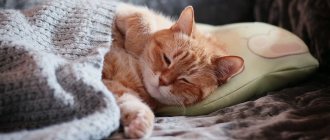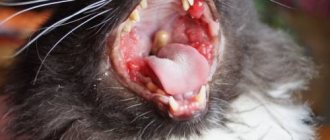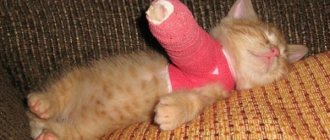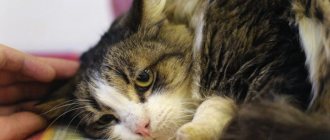Due to their curiosity and mobility, furry pets are often subject to injuries to various organs, including the ears, which result in hematomas. This pathological formation is a hemorrhage of varying degrees into the space between the cartilage and the skin of the ear.
The danger of a hematoma lies in the risk of developing unpleasant complications in the form of inflammatory processes, abscesses and even blood poisoning. After a hematoma, deformation of the auricle often develops.
Causes of auricular hematoma
The development of the disease occurs due to mechanical effects on blood vessels. The cat's ear has thin and delicate skin, is equipped with a numerous capillary network, and therefore often suffers from hemorrhages. Damage to a blood vessel leads to the fact that blood, having no outlet, fills the interstitial space.
In the case of an ear hematoma, blood accumulates in the space between the cartilage tissue of the organ and the skin. The result is swelling, compression of nerve endings, and pain.
The structure of the ears of cats and kittens
The main cause of pathology is mechanical damage. Free-ranging cats have an increased risk of ear hematoma. On the street, such an animal faces many dangers. A cat can injure its ear as a result of a showdown with its relatives, or in fights with its eternal enemies – dogs.
Sometimes the auricle is injured when an animal falls from trees, roofs of houses, or balconies. Often the cause of mechanical damage and subsequent development of hematoma is a collision with a vehicle.
A cat can get a hemorrhage in the ear area not only on the street due to injury. A common cause of the development of the disease are all kinds of non-contagious, infectious and parasitic diseases.
Common otitis media, fungal infections of the auricle, the presence of diseases such as otodectosis and other diseases accompanied by itching in this area force the animal to itch and damage the blood vessels. Self-injury occurs when excessive head shaking occurs due to ear pathologies.
The presence of fleas in a cat, an allergic reaction, or bites of blood-sucking insects is also the cause of the development of hemorrhage due to the mechanical impact on the ear when scratching with its paws.
The cause of a hematoma in a domestic cat can also be surgery in the area of the auricle. In this case, the damage may be completely normal as a consequence of the intervention. A serious postoperative complication develops, as a rule, when the rules of asepsis and antisepsis are not followed, the cauterization of the wound is poor, as well as when the sutures are damaged as a result of violation of the rules of animal care.
We recommend reading about what to do if your cat scratches its ear until it bleeds. You will learn about the reasons for this behavior of your pet, diagnosis at home and examination in the clinic, treatment. And here is more information about how to treat ear mites in a cat.
Drops against ear mites for cats
At the first suspicion of an animal's ear being damaged by a parasite, you should contact a veterinarian to make an accurate diagnosis and prescribe treatment. The presence of a tick can be detected if the cat frequently shakes its head and scratches its ears. As pathology develops, glued fur appears in the lower part of the ear from draining purulent discharge. The symptom of “bowhead”, when the animal constantly tilts the affected ear downwards, indicates a complicated stage of the disease. Nervous seizures are a signal of brain damage, and at this stage the pet will not survive.
Surolan
These tick drops for cats contain the active ingredients (in 1 ml of the drug): miconazole nitrate - 23 mg, polymyxin B sulfate - 0.53 mg, prednisolone acetate - 5 mg. The drug has a uniform consistency and is a white oily liquid. Surolan has an antimicrobial and antifungal effect. Miconazole with polymyxin B have a fungicidal and bactericidal effect. Prednisolone acetate helps restore tissue integrity due to its anti-inflammatory effect.
The method of using Surolan in the complex therapy of otodectosis (ear scabies), complicated by inflammation, consists of instilling the drug into the sore ear, 3-5 drops twice a day until complete recovery, but not longer than 15 days. Contraindications are: individual intolerance, allergy to one or more components of the drug. If a pathological reaction occurs, the animal is prescribed antihistamines or antiallergic drugs. The price of Surolan in Moscow ranges from 707 to 820 rubles.
Amitrazine plus
The active ingredients of these antiparasitic drops are amitraz - 0.003 ml and decamethoxin - 0.0005 ml. The medicine is a bottle with a convenient pipette filled with a yellow oily liquid with a specific odor. The drug has antimicrobial, acaricidal (destroys mites), antifungal effects. The components of the product are effective against resistant tick populations.
The method of using drops for demodicosis is to treat the affected areas once a day with a break of three days. Before applying the medicine, the surface is cleaned of exudate and crusts. Treatment is carried out until complete recovery; a total of 6–8 treatments may be needed. Contraindications are pregnancy of the animal, individual intolerance. The price of Amitrazine Plus drops varies from 59 to 63 rubles.
Leopard
Bars ear drops for cats against fleas and ticks are designed to combat ectoparasites. The medicine contains the following active ingredients: fipronil – 10 mg/ml, diflubenzuron – 1 mg/ml, dicarboximide – 1 mg/ml. In appearance, the drug is a yellowish oily liquid. The combined insectoacaricidal and bactericidal drug has pronounced activity against the sexually mature and larval phases of development of all kinds of parasites. The components of the drug block the receptors of ectoparasites, which leads to their paralysis and death.
After applying Bars drops to the cat's skin, the active substances are evenly distributed over the surface of the pet's body. The dosage is calculated depending on the weight of the animal. To use, you need to part the fur and drip the product onto dry, intact skin in the neck or shoulder blades so that the cat cannot lick off the medicine. The protective effect of the drug lasts for 1-2 months. Drops should not be used on kittens under 8 weeks of age. Contraindication – individual intolerance. The price for Bars drops ranges from 230 to 350 rubles.
Otoferonol Gold
The active ingredients of these drops to combat otodectosis are as follows: synthetic pyrethroid deltamethrin - 0.01%, cycloferon - 0.05%, propolis extract - 0.5%. The product is intended to destroy ear mites in cats, treat purulent otitis media, reduce inflammation and relieve pain. The insecticide Deltamethrin is toxic to pathogens of otodectosis.
The medicine is applied using a dropper bottle into the animal's ears. To destroy the pathogen, a single application is enough; after 5–7 days, the procedure must be repeated to eliminate the descendants of ticks that could hatch during the life of the parasite. Contraindications for use are violation of the integrity of the eardrum, pregnancy and lactation, and kittens up to two months old. The price of Otoferonol Gold drops ranges from 85 to 95 rubles.
Selamectin
The drug is intended for the treatment and prevention of tick-borne diseases (otodectosis, sarcoptic mange) and helminthiasis (hookworm, toxocariasis, dirofilariasis). The active ingredient of the drug is selamectin (from 15 to 240 mg). The drops are packaged in pipettes of 0.25 ml (purple cap), 0.5 ml (brown cap), 1 ml (red cap), 2 ml (dark green cap). The drug has a wide spectrum of action (nematocidal, insecticidal, acaricidal). It has ovicidal (affects helminth eggs) and larvicidal (affects parasite larvae) properties.
Drops are applied to dry skin in the area of the animal's withers, spreading the hair in the neck area or between the shoulder blades. The drug spreads over the skin within 30 minutes, after which the pet can even be washed, but it is advisable to wait 2-3 hours. Contraindications include: kittens under 6 weeks of age or individual intolerance to the components. The price of selamectin-based drugs varies from 200 to 300 rubles.
- Epilator for the bikini area: which is better, reviews
- Sponge cake with sour cream: recipes
- What business is relevant now and what is in demand?
Stages of development
Veterinary specialists note the following stages of the pathological process in the development of hemorrhages in the area of the outer ear in animals.
| Hematoma stage | Period | Short description |
| Stage 1 | On the first day | At this stage of the disease, blood from damaged blood vessels fills the interstitial space. Red blood cells are destroyed and hemoglobin is oxidized. This leads to a change in the color of the blood - it turns blue. The animal has a red or purplish-bluish swelling and mild pain when touched. The degree of pain reaction largely depends on the size of the damage. As a rule, the first stage of hematoma develops within 24 hours after mechanical damage to the soft tissues of the organ. |
| Stage 2 | 2 - 3 days after injury | Along the edges of the hematoma, color changes to a yellowish-blue tint are noticeable. Yellow spots can be observed across the entire surface of damaged tissue. There is moderate pain and swelling in the area of injury. |
| Stage 3 | After 4 - 5 days | The swelling on the skin decreases, there is practically no pain. If the hemorrhage was extensive, then the swelling “slides” to the base of the ear. The swelling becomes greenish in color. |
Such stages are typical for hemorrhages uncomplicated by infection. In case of extensive release of blood from the vessels, failure to provide assistance to the animal in a timely manner at any stage of the disease, an inflammatory process, infection and suppuration of the injury may develop.
Symptoms of a hematoma in a cat
Due to the unique structure of the outer ear, in domestic cats, a frequently occurring hematoma in this area is a superficial type of disease. It will not be difficult for an attentive owner to detect hemorrhage, knowing its main symptoms:
- Change in the normal configuration of the outer ear. It swells, becomes stiff, and sometimes sagging or sticks to the head.
- The ear cartilage becomes hot to the touch (the local temperature rises).
- A limited soft swelling is detected, the size of which depends on the degree of damage to the blood vessels.
- Fluctuation and pain when feeling the swelling.
- The animal shows anxiety, shakes its head, tilts towards the developing pathology.
- The pet's general condition, appetite, and physical activity depend on the severity of the damage. With mild hemorrhage, the owner does not notice a decrease in appetite. In severe forms of hematoma, the animal may refuse to eat due to pain and be in a depressed, lethargic state.
When hemorrhage in the ear area is complicated by an infection, the animal experiences severe pain, an increase in general body temperature, a decrease or complete absence of appetite, and apathy.
Diagnostics of education
Despite the characteristic clinical signs inherent in a hematoma, it is difficult for the owner to independently determine the disease; he should seek help from professionals. After examining the ear, a veterinarian may prescribe additional examination methods. The fact is that owners often confuse hemorrhage with diseases such as tumors of various etiologies, dermatitis and allergic manifestations.
Treatment of the auricle
The choice of treatment tactics for the disease largely depends on the size of the hemorrhage and the stage of the pathological process. For small hematomas, cold is indicated in the first hours after injury. Frozen foods from the freezer wrapped in cloth are suitable for this purpose. You can cool the damaged ear for 10 - 15 minutes.
If there is an open wound, it is treated with disinfectants. To reduce blood leakage, a pressure bandage is applied to the ear.
If the hematoma occurs as a result of an allergy, an infectious or parasitic disease, or otitis media, then priority attention is paid to the underlying disease.
For extensive hematomas, due to the fact that there is a high risk of infection, the most effective method of treatment is surgery. In addition, when the pathology progresses spontaneously in the final stage, fibrinous tissue grows at the site of damage. This leads to deformation of the ear cartilage, which is undesirable for show animals.
During the operation, the veterinarian opens the hematoma using an incision at the base of the ear. Blood clots and fibrin are removed. At the end of the manipulation, a fixing suture and bandage are applied. Surgery is usually performed under local anesthesia. After the operation, the animal must be in a special collar that prevents the paw from scratching the ear.
Pumping out blood with a syringe
The positive aspect of the surgical treatment method is the minimal risk of relapse, as well as the preservation of the natural shape of the ear cartilage. The disadvantages of surgery include a small stitch in the cat's ear.
In addition to surgical treatment, a veterinarian can use special dressings for show animals. A special feature of this method of treating hematoma is the absence of postoperative scars. The disadvantage is that the owner cannot apply the bandage himself; constant visits to the veterinary clinic are required.
A common way to treat small, fresh hematomas is to drain the blood with a syringe. The method is often used when the blood that has escaped from the blood vessels has not yet clotted.
Ointments for the treatment of ear hematoma in cats
Anti-inflammatory and antibacterial ointments are widely used in the treatment of the disease: levomycin, syntomycin, levomycin. For suppuration, ichthyol and Vishnevsky ointment are used. Additionally, if the hematoma becomes infected, the animal is prescribed a course of antibacterial therapy. For this purpose, penicillin antibiotics, tetracyclines, and cephalosporins are used.
We recommend reading about how to clean your cat's ears at home. You will learn about the importance of clean ears, the necessary materials for the procedure, cleaning techniques, and a special approach to kittens. And here is more information about the treatment of otitis media in cats.
Conservative methods of treating ear hematoma:
Aspiration using a surgical needle . This method is suitable for cases where complex surgical intervention can be avoided. The hematoma is punctured with a needle and the liquid is sucked out using a syringe. Hormones and antibiotics are injected back into the cavity through the same needle into the hematoma cavity. In general, the method is not reliable, and a positive result is not always achieved. And the aspiration procedure, as a rule, needs to be repeated from 3 to 7 times. Installation of capillary drainage into the hematoma cavity. Possible with some perseverance from the patient. The inner surface of the auricle is treated with a topical anesthetic, then local anesthesia is performed. The hematoma is opened and a silicone strip is inserted into its cavity - drainage. Through it, all newly formed fluid is removed from the hematoma. The swelling cannot form again and gradual fusion of the cavity occurs. The method is effective only in the case of constant compression on the area of the hematoma, so with this method of treatment you always have to tightly press the ear to the head with elastic bandages for the entire healing period. This is not always technically possible, and without this condition the method does not work well. Ointments and compresses. This is perhaps the most unreliable method of treating otohematomas. It is used only in cases where it is impossible to contact a veterinarian. It works sometimes, but more often it is used to delay the development of a hematoma and relieve inflammation from it, until it can be examined by a doctor. Ointments containing hormonal, cooling, vasoconstrictive and capillary blood supply components are applied to the swelling. Plus, hot compresses containing dioxidin, dimexide, novocaine and hormones are applied to the hematoma for 20-30 minutes 2 times a day.
[custom_ads_shortcode1]
Prevention of hemorrhages in cats
In order to prevent such an unpleasant illness as hemorrhages on the outer ear of animals, veterinary experts recommend that owners adhere to the following rules:
- Prevention of injuries and mechanical damage to the ear. Sterilization and castration of pets and restricting the cat’s free access to the street help reduce their risk.
- Timely treatment of ear diseases, including tick-borne, fungal and infectious etiologies.
- Identification of allergen and treatment of allergic manifestations in cats.
- Prevention of infection of an animal with parasites (use of special collars, long-term drops, etc.).
Hematoma of the ear in domestic cats is not such a rare phenomenon. Thin skin and many blood vessels contribute to the development of hemorrhage even with minor organ trauma. The characteristic clinical signs of the disease, however, require confirmation from professionals.
One effective treatment is surgical removal of blood clots. For show animals with minor injuries, special bandages are applied. The owner should be aware that hematomas can become infected and lead to deformation of the ear cartilage. In this regard, self-medication is unacceptable.
Treatment
Surgical treatment is considered the most effective treatment for ear hematomas. Under anesthesia, an incision is made in the animal along the hematoma on the inner surface of the ear. After the fluid and blood clots are removed, the inside of the ear is sutured downwards. The sutures seem to connect the inner and outer surfaces with each other, so the scars are formed quite smooth and uniform. The stitches are usually left in place for several weeks, leaving the incision half open so that fluid will continue to drain from the ear as it heals. After the fluid is completely released and the hematoma resolves, the sutures heal. In “lop-eared” dogs, after surgery, the ears are most often raised up and secured behind the head so that healing occurs safely and the animal does not cause itself pain. An Elizabethan collar (a cone-shaped cap that fits on the animal's head) is also recommended - this will prevent the animal from accidentally damaging or scratching the operated ears. Another type of treatment involves placing a small drainage tube in the outside of the ear. The tube remains in place for several weeks while the fluid drains and the ear heals. The main disadvantage of this technique is that not all animals are ready to put up with this, and cat ears, as a rule, are too small to accommodate this drainage “structure”. In some cases, veterinarians may be able to draw out the accumulated fluid using a syringe. Special medications are also used that are injected into the hematoma to reduce swelling and inflammation. In these cases, however, relapse of the disease and deformation of the auricle are more likely. If the disease is caused by an infection or an ear mite, the veterinarian treats and cleans the ears with special ointments and solutions, which can not only relieve the animal of a hematoma, but also prevent it if timely contact a specialist. Otohematoma is not life-threatening and can go away without treatment, but the animal suffers longer and more severely. In addition, if not treated correctly, a dog or cat's ears often develop thickened, wrinkled scar tissue, which not only looks unnatural and unsightly, but also causes discomfort for the pet.
[custom_ads_shortcode3]
Useful video
For information on parasitic ear diseases in cats, watch this video:
Similar articles
- How to clean a cat's ears at home, how to do this...
Healthy ears: why is this so important? A cat's hearing is no less important than vision, giving it an idea of the world around it. ... Therefore, to preserve hearing for many years, it is important to regularly clean your cat's ears. Read more - Treatment of otitis media in cats: symptoms of purulent and fungal...
Effective treatment of otitis in cats. Middle ear disease in domestic cats is called otitis media. This is a widespread pathology of the hearing organs. Read more
- The cat scratched its ear until it bled: what to do if it itches...
Examination of the animal may reveal a foreign body, hematoma, or lymphatic extravasation. ... A veterinarian is the best person to know what to do if a cat’s ears itch. Read more
- How to treat a cat’s wound (open, purulent) after...
After such walks, the animal often has wounds on the head, ears, body and limbs. ... What to use to treat an open wound in a cat depends on the further development of the traumatic process. Read more
- The cat’s tumor has opened or burst, broken through...
What to do if your cat has a tumor? Mammary gland neoplasms are a widespread pathology among furry beauties. ... A cat has tubercles on its ears: how to treat it, what to do if... Read more
Prevention
To avoid the development of a hematoma on a cat’s ear, the owner must carry out hygiene procedures: once a week, clean the hearing organ with special veterinary lotions “Beafar”, “Trixie”, “Otifri”, “SkinMed Otic”. Veterinarians recommend antiparasitic treatment for cats, especially those visiting the street. You should protect your pet from hypothermia to prevent otitis media. To prevent the cat from getting injured during play, the owner needs to remove bulky decorative items that the pet can push over.











